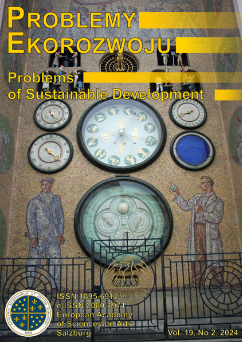Selected methods of water resources accounting in the aspect of sustainable development
Marcin K. Widomski
Faculty of Environmental Engineering, Lublin University of Technology, Nadbystrzycka 40B, 20-618 Lublin (Poland)
Abstract
Fresh water is one of the most important natural resources required by the societies’ proper operation to meet their biological and industrial needs. Thus, water is a key resource, which availability or scarcity, should be considered carefully in strategies of sustainable social, economic and technical development, with full respect to nature and rules of intergenerational justice. Preservation of fresh water resources for the next generations is highly required by the rule of sustainable development, which results in the need for water accounting for industry and services located in the given watershed as well as for the proper, sustainable water management. This paper contains presentation and analysis of five popular methods used in industrial water accounting i.e. Water Footprint, Life Cycle Assessment, Global Water Tool, Water Sustainability Tools and the exemplary industrial method developed by Schornagel. The apllicational abilities of the described methods and the attempt of the presented methods assessment in compliance to the three main priorities of sustainable development were discussed. The set of basic requirements met by the method orientated towards sustainable development was also presented.
Keywords:
sustainable development, water resources, industrial water demand, waste water, industrial water balance, sustainable water managementReferences
ARTHUR J. D., URETSKY M., WILSON P., Water Resources and Use for Hydraulic Fracturing in the Marcellus Shale Region, ALL Consulting, LLC 2010.
Google Scholar
BAJKIEWICZ-GRABOWSKA E., MIKULSKI Z., Hydrologia ogólna, PWN, Warszawa 1999.
Google Scholar
BAYART J-B, BULLE C, DESCHENES L, MARGNI M, PFISTER S, VINCE F, 2010, A framework for assessing off-stream freshwater use, in: International Journal of Life Cycle Assessment vol. 15, p. 439-453.
Google Scholar
BHAMIDIMARRI R., BUTLER K., 1998, Environmental engineering education at the millenium: An integrated approach, in: Water Science and Technology, vol. 38, no. 11, p. 311-314
Google Scholar
CHEŁMICKI W., Woda. Zasoby, degradacja, ochrona, PWN, Warszawa 2002.
Google Scholar
GUAN D., HUBACEK K., 2008, A new integrated hydro-economic accounting and analytical Framework for water resources: A case study for North China, in: Journal of Environmental Management vol. 88, p. 1300-1313.
Google Scholar
HARDING R., 2006, Ecologically sustainable development: origins, implementation and challenges, in: Desalination, vol. 187, p. 229-239.
Google Scholar
HARRIS J.M., WISE T.A., GALLAGHER K.P., GOODWIN N.R, A Survey of Sustainable Development, Social and Economic Dimensions, Island Press, Washington, Covelo, London 2001.
Google Scholar
HOEKSTRA, A.Y., CHAPAGAIN, A.K., ALDAYA, M.M. AND MEKONNEN, M.M., The water footprint assessment manual: Setting the global standard, Earthscan, London, 2011.
Google Scholar
HUANG J., ZHANG H.-L., TONG W.-J., CHEN F., 2012, The impact of local crops consumption on the water resources in Beijing, in: Journal of cleaner Production vol. 21, p. 45-50.
Google Scholar
KESTEMONT B., FRENDO L., ZACCAI E., 2011, Indicators of the impacts of development on environment: A comparison for Africa and Europe, in: Ecological Indicators, vol. 11, p. 848-856.
Google Scholar
KOEHLER A., 2008, Water use in LCA: managing the planet’s freshwater resources, in: International Journal Life Cycle Assessment vol. 13, p. 451-455.
Google Scholar
KOZŁOWSKI S., Ekorozwój – wyzwanie XXI wieku, PWN, Warszawa 2000.
Google Scholar
MARIOLAKOS I., 2007, Water resources management in the framework of sustainable development, in: Desalination, vol. 213, no. 1-3, p. 147–151.
Google Scholar
MILÁ I CANALS L., CHENOWETH J., CHAPAGAIN A., ORR S., ANTON A., CLIFT R., 2009, Assessing freshwater use impacts in LCA. Part I. Inventory modelling and characterisation fac-tors for the main impact pathways, in: International Journal of Life Cycle Assessment vol. 14, p. 28-42.
Google Scholar
OWENS J., 2001, Water resources in life-cycle impact assessment, in: Journal of Industrial Ecology vol. 5, p. 37-54.
Google Scholar
PALME U., LUNDIN M., TILLMAN A.M., MOLANDER S., 2005, Sustainable development indicators for wastewater systems – researchers and indicator users in a co-operative case study, in: Resources, Conservation and Recycling, vol. 43, no. 3, p. 293-311.
Google Scholar
PALME U., TILLMAN A.M., 2008, Sustainable development indicators: how are they used in Swedish water utilities, in: Journal of Cleaner Production, vol. 16, no. 13, p. 1346-1357.
Google Scholar
PAWŁOWSKI A, 2010, The role of environmental engineering in introducing sustainable development, in: Ecological Chemistry and Engineering S, vol. 17, no. 3, p. 264-278.
Google Scholar
PAWŁOWSKI A., 2008, How Many Dimensions Does Sustainable Development Have?, in: Sustainable Development vol. 16 no 2, p. 81-90.
Google Scholar
ISO 14040:2006. Environmental management. Life cycle assessment.
Google Scholar
POSTEL S.L., DAILY G.C., ENRLICH P.R., 1995, Human appropriation of renewable fresh water, in: Science vol. 271, p. 785-788.
Google Scholar
U.S. ENVIRONMENTAL PROTECTION AGENCY, 2010, Hydraulic Fracturing Research Study, EPA/600/F-10/002.
Google Scholar
WCED (World Commission of Environment and Development), Our Common Future, Oxford University Press, New York 1987.
Google Scholar
Authors
Marcin K. WidomskiFaculty of Environmental Engineering, Lublin University of Technology, Nadbystrzycka 40B, 20-618 Lublin Poland
Statistics
Abstract views: 12PDF downloads: 13
License

This work is licensed under a Creative Commons Attribution-ShareAlike 4.0 International License.




